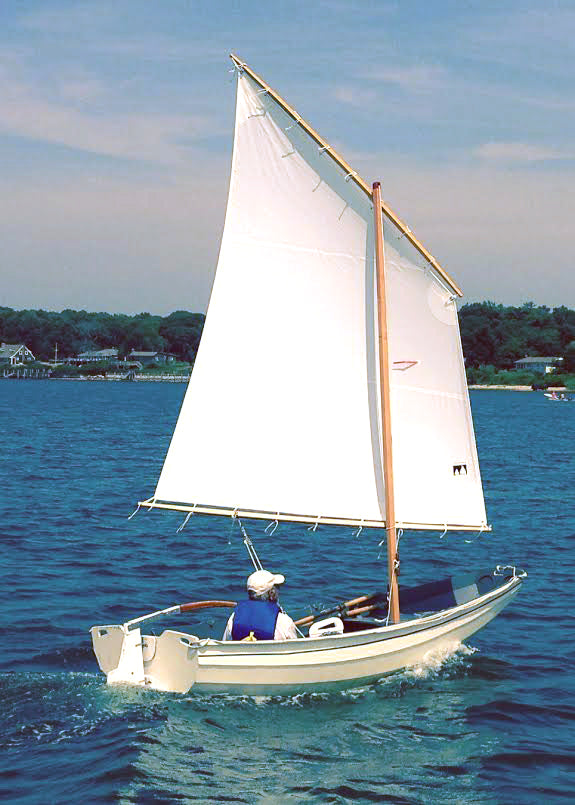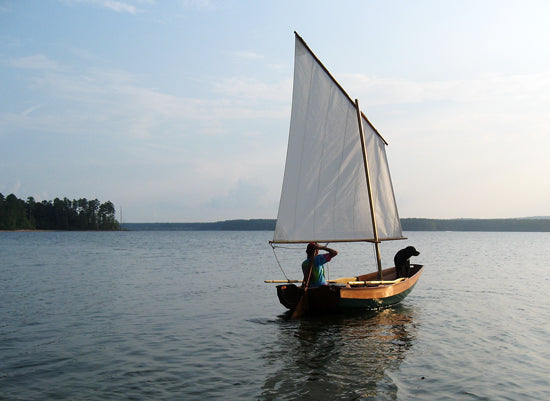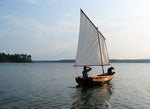Specifications
Performance
Stability
Speed
Cockpit Room
Payload
Ease of Construction

Overview
The Passagemaker Dinghy is a handy boat that can be rowed, sailed, and powered with up to three adults aboard. Easy to build. Looks great . Performs beautifully. A smooth glide when rowing, spirited performance when sailing, and steady handling with an outboard make this design a gem in our fleet of graceful build-it-yourself boat kits.
This is the perfect dinghy for folks with larger boats. Are you tired of moving heavy, traditional dinghies that weigh 200 pounds, or struggling with a limp, awkward inflatable that can't be rowed or sailed? CLC designer John C. Harris has drawn an elegant, Norwegian-styled pram that weighs only 90lbs, but can survive real abuse in the dinghy park. With a 650-pound payload, the Passagemaker can haul the entire crew in one go, or ferry blocks of ice and jerrycans of drinking water from the quayside to the mothership. The sailing rig components store flat inside the 11'7" hull; fasten three shrouds and the mainsheet, hoist up the mainsail and jib, and you've got a fast, fun, stable sailing dinghy that will please even the most ardent and discriminating sailing enthusiast.
If you have a long harbor to cross, a 2-, 3-, or 4-horsepower outboard will drive the Passagemaker to harbor speed limits and beyond. Transom height is 15 inches, sized for short-shaft outboards. An electric outboard for lake fishing will work great, too. If you don't want to lug around an outboard and smelly gas, you'll be delighted to discover how well the Passagemaker rows: there's plenty of rocker for low wetted surface and the transom won't drag in the water, so it won't slow you down.
See what Sailing magazine had to say about the Passagemaker.
Easy to Build
The Passagemaker Dinghy is well within the reach of first-time boatbuilders. There are no tricky steps and no special tools are needed. Completion will average 100 hours for the sailing version. The daggerboard trunk is included in the base kit, so you can upgrade to the sailing option at any time in the future.
Optional Lug Rig: There is an option for a lug rig, which is substituted for the stock sloop rig. It uses a free standing mast, offers somewhat simpler handling both ashore and on the water. While not as fast upwind, the lug rig still provides serious horsepower and includes a set of reef points for extra windy days.
Passagemaker Take-Apart
We've had hundreds of requests for a take-apart dinghy. Take-aparts or "nesting" dinghies can be disassembled to take up less space when stored on the deck of a trawler or sailing yacht. The Passagemaker Take-Apart is identical to the standard kit, except that the front 45" unbolts and stows in the rear 93" of the hull. The interiors of both standard and Take-Apart versions are identical; there are no compromises made to rowing, sailing, powering, or towing ability in the Take-Apart design, although the Take-Apart weighs about four pounds more. Outwardly it's actually difficult to tell the difference between them.

Read featured articles about the Passagemaker Dinghy in Small Boats Nation:

What builders are saying
Main Gallery
Construction Gallery
Line Drawings
Videos
Frequently Asked Questions
Take One of our Boatbuilding Classes
We offer classes for many of the boats we sell. Teaching sites stretch from Maryland to Washington State and from Maine to California. Click here to find out more.
View ClassesNeed Help Building it?
We’re here to help with any questions you might have during the build process.
















































































































































































